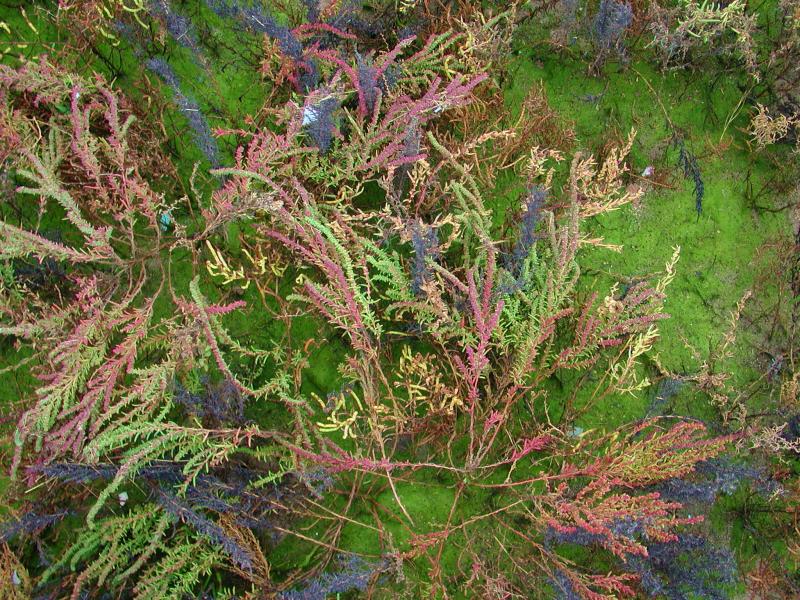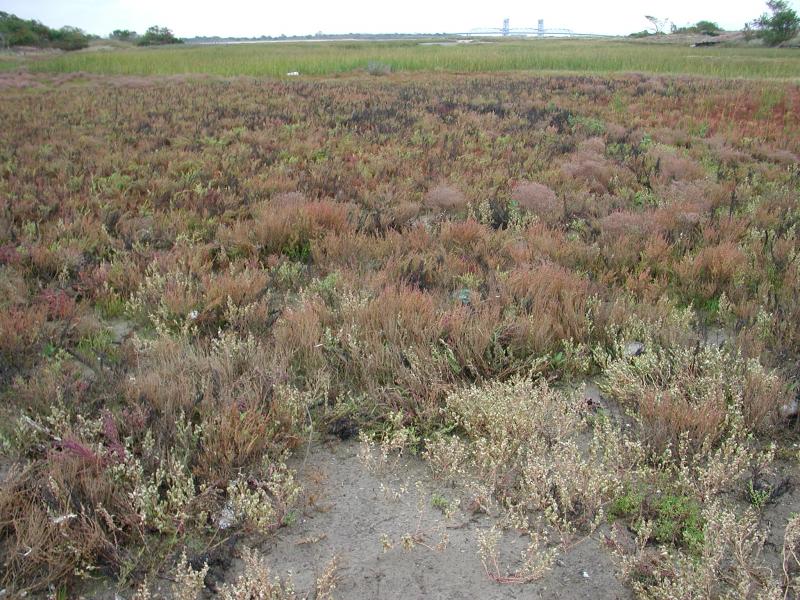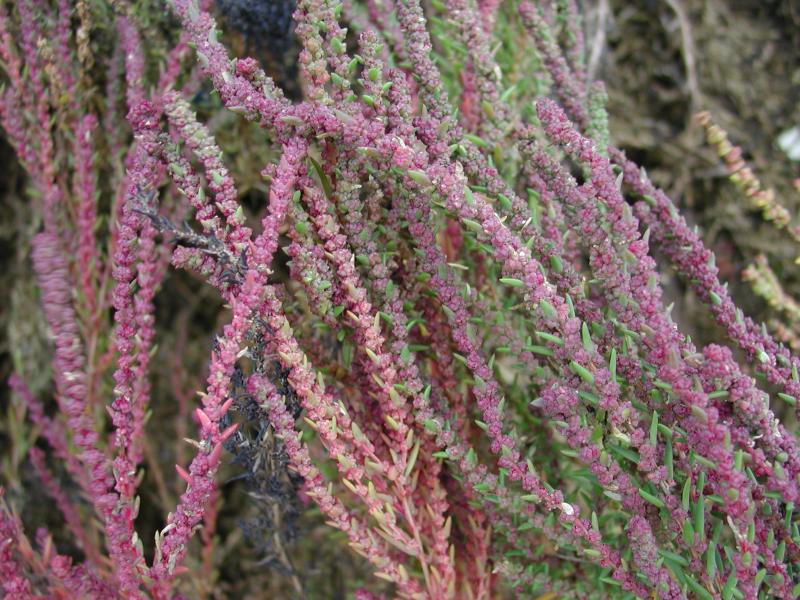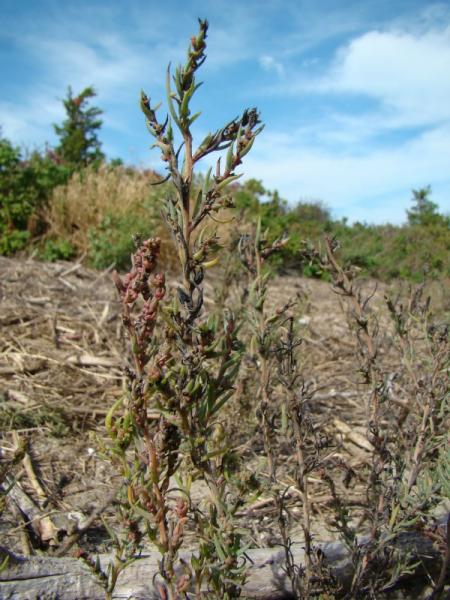Roland's Seablite
Suaeda rolandii Bassett & Crompton
- Class
- Dicotyledoneae (Dicots)
- Family
- Amaranthaceae (Amaranth Family)
- State Protection
- Endangered
Listed as Endangered by New York State: in imminent danger of extirpation in New York. For animals, taking, importation, transportation, or possession is prohibited, except under license or permit. For plants, removal or damage without the consent of the landowner is prohibited.
- Federal Protection
- Not Listed
- State Conservation Status Rank
- S1
Critically Imperiled in New York - Especially vulnerable to disappearing from New York due to extreme rarity or other factors; typically 5 or fewer populations or locations in New York, very few individuals, very restricted range, very few remaining acres (or miles of stream), and/or very steep declines.
- Global Conservation Status Rank
- G1G2
Critically Imperiled or Imperiled globally - At very high or high risk of extinction due to rarity or other factors; typically 20 or fewer populations or locations in the world, very few individuals, very restricted range, few remaining acres (or miles of stream), and/or steep declines. More information is needed to assign either G1 or G2.
Summary
Did you know?
Roland's sea-blite was not recognized as a separate species until 1978. It was named after Albert G. Roland, the author of the Flora of Nova Scotia (Bassett and Crompton 1978).
State Ranking Justification
There are six existing populations, but all of them are small with less than 200 plants. No other historical records are known.
Short-term Trends
The short-term trend is unknown. Most of the known populations have been visited only once in recent decades and additional visits are needed to determine their trend.
Long-term Trends
The long-term trend in number of populations appears to be stable.This plant has always been very rare in New York. All the known historical populations have been rediscovered.
Conservation and Management
Threats
Four populations occur in areas with a lot of human and boat activity which threatened these populations by direct disturbance. Encroachment by Phragmites is a threat to some of the other populations.
Conservation Strategies and Management Practices
Controlling the spread of Phragmites may benefit some populations.
Research Needs
Research is needed to determine whether the populations of Suaeda rolandii on Long Island have separate origins from Canadian populations of the (putatively) same species.
Habitat
Habitat
In New York, Roland's Sea-blite grows in open, salt-influenced wetlands, including the upper portions of high salt marshes, in salt pannes or swales within brackish tidal marsh, and similar habitats occurring on dredge spoils (New York Natural Heritage Program 2011). Tidal flats, salt marshes (FNA 2003). Salt marshes (Clemants 1992).
Associated Ecological Communities
- Brackish tidal marsh
(guide)
A marsh community that occurs where water salinity ranges from 0.5 to 18.0 ppt, and water is less than 2 m (6 ft) deep at high tide. The vegetation in a brackish tidal marsh is dense and dominated by tall grass-like plants.
- Dredge spoil wetland*
A wetland in which the substrate consists of dredge spoils; reedgrass is a characteristic species.
- High salt marsh
(guide)
A coastal marsh community that occurs in sheltered areas of the seacoast, in a zone extending from mean high tide up to the limit of spring tides. It is periodically flooded by spring tides and flood tides. High salt marshes typically consist of a mosaic of patches that are mostly dominated by a single graminoid species.
* probable association but not confirmed.
Associated Species
- Baccharis halimifolia (groundsel-tree)
- Carex silicea (beach sedge)
- Distichlis spicata (salt grass)
- Drosera filiformis (thread-leaved sundew)
- Drosera intermedia (spatulate-leaved sundew)
- Juncus gerardii
- Limonium carolinianum (sea-lavender)
- Lycopodiella appressa (appressed-leaved bog-clubmoss, swamp bog-clubmoss)
- Myrica pensylvanica
- Panicum virgatum (switch grass)
- Parthenocissus quinquefolia (Virginia-creeper)
- Phragmites australis (old world reed grass, old world phragmites)
- Plantago maritima var. juncoides (seaside plantain)
- Prunus serotina
- Rhus copallinum
- Sabatia stellaris (sea-pink)
- Salicornia bigelovii (Bigelow's glasswort)
- Salicornia depressa (slender glasswort)
- Solidago sempervirens (northern seaside goldenrod)
- Spartina alterniflora (smooth cord grass)
- Suaeda calceoliformis (horned sea-blite)
- Suaeda linearis (southern sea-blite)
- Suaeda maritima
Range
New York State Distribution
This saltmarsh plant is currently known from Queens and Suffolk counties with historical records in Nassau County and Brooklyn.
Global Distribution
Roland's Sea-blite is rare throughout its current range from Nova Scotia and New Brunswick in Canada and New York's Long Island. It is also historically known from both coastal Québec and New Jersey.
Identification Comments
General Description
Suaeda rolandii is an annual (at least in New York) herbaceous species with a woody taproot. It is normally erect or ascending and single-stemmed, up to 70 centimeters tall, and branching only from the upper stem. The leaves are fleshy and succulent, linear, and up to 3 centimeters long. The flower heads are distributed throughout the main stem and lateral branches. The sepals are hooded and keeled, somewhat unequal, and 2 to 4 millimeters wide (FNA 2003). The seeds are lens-shaped, black, and 1.5 to 2.3 millimeters in diameter. (FNA 2003, Clemants 1992). It may be our first Suaeda to turn red in autumn.
Best Life Stage for Proper Identification
Plants with mature fruits are best for identification.
Similar Species
Suaeda rolandii superficially resembles a larger, more succulent, and erect S. maritima, but S. rolandii flowers and fruits later in the season, and its flowers have unequal, unkeeled sepals, unlike the rounded sepals of S. maritima. Its fruits have larger seeds (1.5 to 2.0 millimeters in diameter) than those of the other two New York Suaeda species, S. linearis and S. calceoliformis (10 to 1.5 mm) (Clemants 1992).
Best Time to See
Fruiting plants should be present October and into November.
- Fruiting
The time of year you would expect to find Roland's Seablite fruiting in New York.
Roland's Seablite Images
Images of Similar Species
Taxonomy
Roland's Seablite
Suaeda rolandii Bassett & Crompton
- Kingdom Plantae
- Phylum Anthophyta
- Class Dicotyledoneae
(Dicots)
- Order Caryophyllales
- Family Amaranthaceae (Amaranth Family)
- Order Caryophyllales
- Class Dicotyledoneae
(Dicots)
- Phylum Anthophyta
Additional Common Names
- Roland's Sea Blite
- Sea-blite
Synonyms
- Suaeda maritima (L.) Dumort. [in part.]
Comments on the Classification
An allotetraploid from a cross between S. maritima and S. calcolariformis (=americana). Described in 1978 by Basset and Crompton in J. Canad. Bot. 56:588.
Additional Resources
Best Identification Reference
Clemants, Steven E. 1992. Chenopodiaceae and Amaranthaceae of New York State. Bulletin No. 485. New York State Museum. Albany, NY.
Other References
Bassett, I.J. and C.W. Crompton. 1977. The genus Suaeda (Chenopodiaceae) of Canada. Canadian Journal of Botany 56: 581-591.
Flora of North America Editorial Committee. 2003. Flora of North America North of Mexico, Volume 4, Magnoliophyta: Caryophyllidae, Part 1. Oxford University Press, New York.
Gleason, Henry A. and A. Cronquist. 1991. Manual of Vascular Plants of Northeastern United States and Adjacent Canada. The New York Botanical Garden, Bronx, New York. 910 pp.
Holmgren, Noel. 1998. The Illustrated Companion to Gleason and Cronquist's Manual. Illustrations of the Vascular Plants of Northeastern United States and Adjacent Canada. The New York Botanical Garden, Bronx, New York.
Mitchell, Richard S. and Gordon C. Tucker. 1997. Revised Checklist of New York State Plants. Contributions to a Flora of New York State. Checklist IV. Bulletin No. 490. New York State Museum. Albany, NY. 400 pp.
New York Natural Heritage Program. 2010. Biotics database. New York Natural Heritage Program. New York State Department of Environmental Conservation. Albany, NY.
New York Natural Heritage Program. 2024. New York Natural Heritage Program Databases. Albany, NY.
Weldy, T. and D. Werier. 2010. New York flora atlas. [S.M. Landry, K.N. Campbell, and L.D. Mabe (original application development), Florida Center for Community Design and Research http://www.fccdr.usf.edu/. University of South Florida http://www.usf.edu/]. New York Flora Association http://newyork.plantatlas.usf.edu/, Albany, New York
Links
About This Guide
This guide was authored by: Richard M. Ring
Information for this guide was last updated on: November 4, 2011
Please cite this page as:
New York Natural Heritage Program. 2024.
Online Conservation Guide for
Suaeda rolandii.
Available from: https://guides.nynhp.org/rolands-sea-blite/.
Accessed July 26, 2024.



